Technology for real-time electronic music performance has seen significant progress in the last decade. Flexible non-linear digital audio workstations like Ableton Live combined with plug and play hardware control offer remarkable potential for streamlined access to the stage and direct connection to fans and audiences. Despite the fact that all of this is more accessible than ever, creating unique personalized setups can still be challenging. With so many choices available, and with add-ons like Max for Live and Reaktor, the possibilities are truly endless. It's extremely easy to get lost dreaming up “what could be” while experimenting with infinite possibilities, rather than accomplishing what we initially set out to do... perform!
"Creating unique personalized setups can be challenging with so many choices available, and with add-ons like Max for Live and Reaktor, the possibilities are truly endless."
Where to start?
To create a setup that is tailored to meet your individual artistic needs, I recommend beginning with a proper brainstorming session. Personally, I find it useful to get out from behind the computer, with some good old fashioned paper and a pencil, and start scratching out lists and diagrams. Solidify ideas by asking relevant questions that define a specific plan of attack and help prioritize what is most substantial. Both technical and aesthetic considerations are important as one side often influences the other.
What you learn from this exercise will assist keeping you on track, focused, organized, and directed. It's important to note, once you start implementing your ideas, anything not on the list should be considered a distraction from your true mission. If you really believe something needs to be included, go back to the list and re-prioritize to account for the addition.
Your live performance starts before you get on stage… in the planning process.
Below are a few preliminary thoughts to ponder at this stage:
- What is the purpose of my performance (Solo Instrumentalist, DJ set, Live Remixing, Audio/Visual Instrument, Acousmatic presentation, etc.)?
- What is my model's primary function? Is it an instrument, an effects processor, an interactive system, a playback device or is it a hybrid combination?
- If it is a combination of various elements, which of these are highest and lowest in importance and priority? Which of these tasks require the most resources and how might this play into how I have prioritized?
- What do I want to be doing during any given point in my performance? Equally important, what do I NOT want to be doing?
- What aspects of my setup are most important and which are least important? What is essential and, if push comes to shove, what am I willing to sacrifice or compromise?
- How do I envision myself as a performer? Does my rig allow for this? If not, how can it be modified to meet my needs?
- How much of my set will be predetermined and how much will be improvised (very important!)?
- Who is my intended audience? (If it's of significance) how entertaining and/or engaging will my performance be and how will it stand up under various conditions?
- What types of environments will I be playing in? What types of situations or locations will my setup be affected, enhanced or limited by?
The process at this stage is much like writing an essay. Define a thesis or topic, add supporting details and discard ideas that are irrelevant. The more complete an outline you create, the easier it will be stay on target.
"Remember to try and keep your ideas honed, simple and concise and avoid paradoxical and contradictory concepts."
Think about the overall main idea first and determine how this will work in conjunction with smaller sub-sections. Remember to try and keep your ideas honed, simple and concise and avoid paradoxical and contradictory concepts. For example, it's not feasible to expect to run a multitude of virtual instruments and processor-hungry plug-ins simultaneously and still be able to keep your buffer low enough to avoid latency when running inputs through your software (although, this is one of the most encountered issues in a majority of my client's setups!)
An example Ableton Live setup.
To illustrate what your brainstorm might look like. The following example demonstrates some preliminarily considerations for a solo live performance setup.
Example
Main Goal: Play synth accompaniment via virtual instruments, trigger clips and samples over pre-arranged backing material, modulate real-time effects.
Consider these points for your brainstorming session.
Every model should have a somewhat different set of priorities based upon unique criterion. As my role changes, so does my focus and my performance system's layout. I recommend avoiding the idea of an “all purpose” performance setup that is capable of anything at anytime. Like most fine things in life, custom fit means it's unique and tailored to meet specific needs for specific situations. I'm not necessarily suggesting that you'll need to build everything from the ground up each time you perform, but it is a great idea to consider whether or not your setup might benefit from modification or additional fine tuning before the next gig.
"I recommend avoiding the idea of an 'all purpose' performance setup that is capable of anything at anytime."
There are some well designed templates floating around the internet for Live performance and DJing. These can be great jumping off points for creating custom rigs and it is amazing how much you can learn from backwards engineering.
As you brainstorm, watch videos and read articles to help get ideas and inspiration, investigate how other artists with similar performance styles are approaching their setups and consider which aspects are similar and dissimilar to your own.
Timo Preece enjoying an excellent performance thanks to his extensively well-planned brainstorming session!
Most importantly, do not settle on a performance dynamic simply because you feel limited by the technology you are using. Creativity is the hub of great invention and invention is realized by first knowing what you want, devising a well designed plan, and putting it into action.







 © 2024 Ask.Audio
A NonLinear Educating Company
© 2024 Ask.Audio
A NonLinear Educating Company
Discussion
Want to join the discussion?
Create an account or login to get started!